What Do You Expect?
I looked for a second Stanley 60 1/2 block plane of the old style but didn’t want to pay the price they were going for. In the end, I bought two, a secondhand one for £39 and then a new one for £50. The new one was so very disappointing and I’ll go through the fixing of it shortly. I did know what I wanted in one plane though and that was a non-negotiable; the older version that I currently own has no lateral adjustment so you must set parallelity at the cutting edge by a swivel here or there to get things aligned at the business end. I generally set by eye along the sole looking into the cutting edge in relation to the sole face to start and then use light hammer taps from my Warrington hammer for the final set. This works as well as using the lateral adjuster in the newer models and is just as quick if not quicker. The newer models have a somewhat rickety and quirky lateral adjustment mechanism and an adjustable mouth closure to open and narrow the throat opening. Funny thing though, both of these had problems that rendered then useless. The US versions of vintage class were really much more reasonably priced on ebay compared to their UK cousins but, of course, any saving is offset by shipping costs – always prohibitive. I’m really not at all interested in the regular block planes with a higher bed angles of 20º. Combining the bevel of 25-30º pans out at a steep presentation and my #4 does a better job; I like the 12-15º bed angle because it will do everything the steeper version will do and more much better.
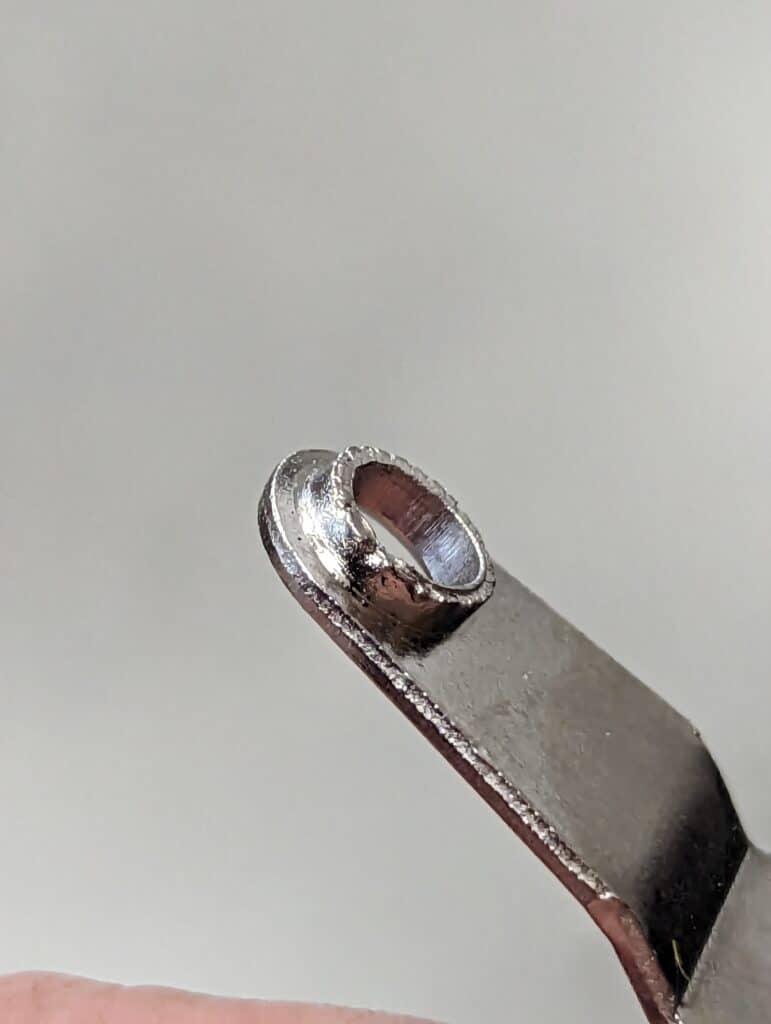
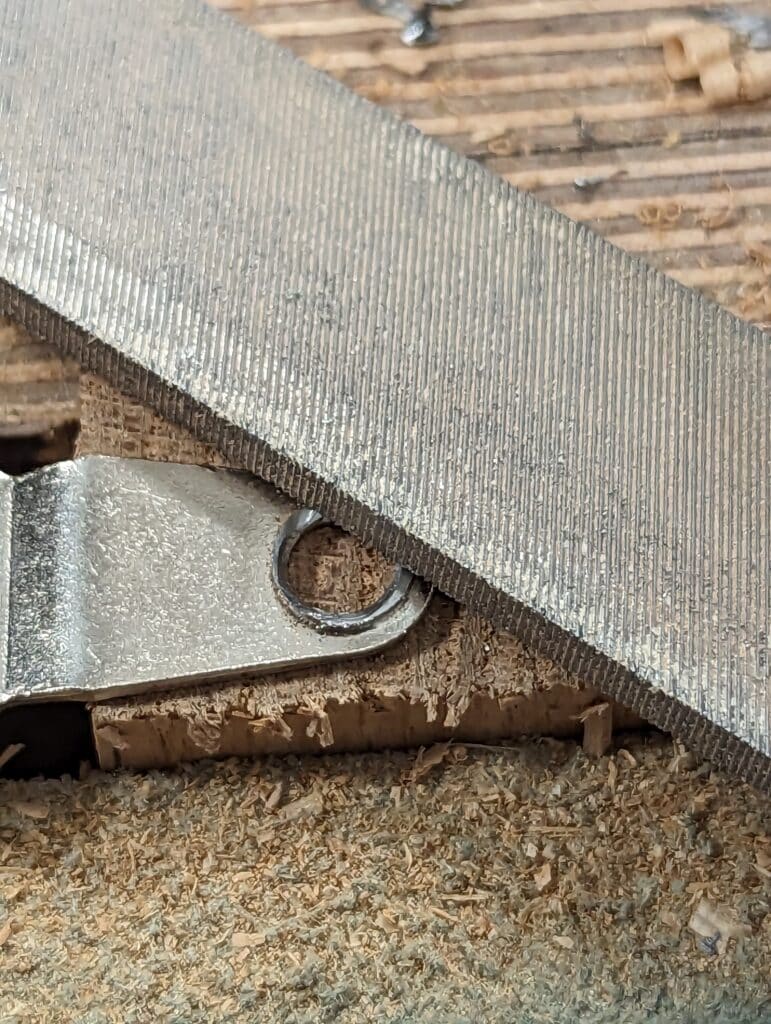
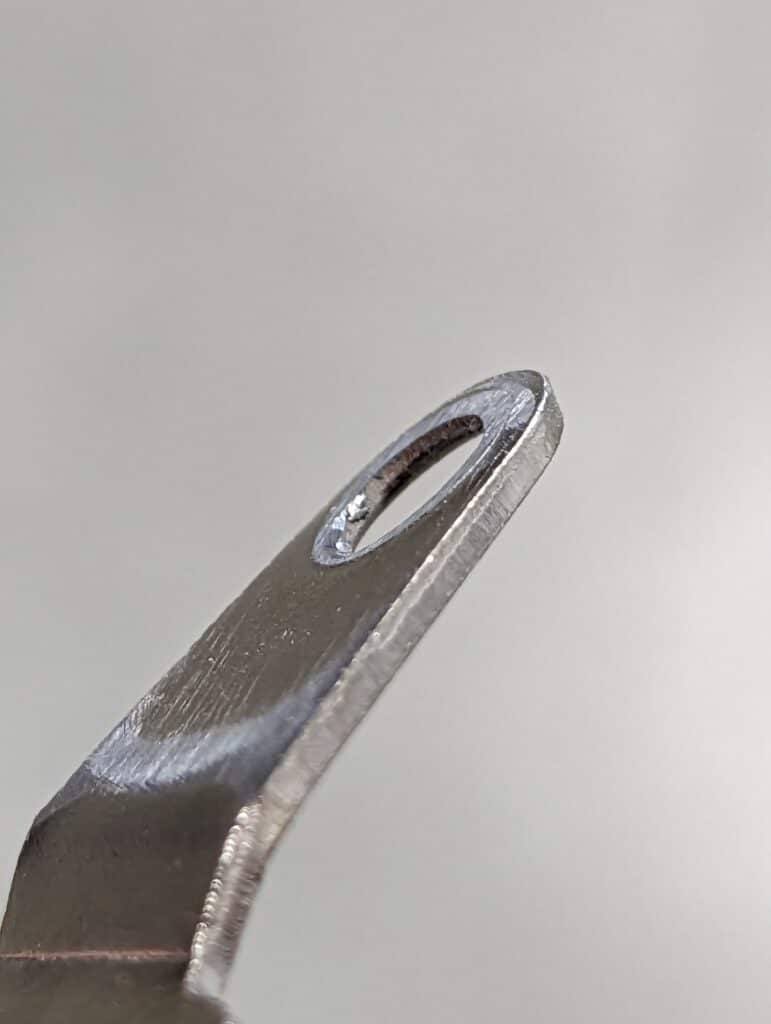
As I struggled to think about prices for my audience I remembered that Spear & Jackson had come back online making Bailey-pattern #4 and #5 planes of a fairly decent quality for bench planes. These two needed only a small amount of fettling to get a good and positive outcome at a much more affordable price and the planes were definitely good enough for long term use without compromising functionality at all. I ordered the S&J 9 1/2 block plane just to see what it was like but the box it came in alone said it was more than I really wanted. The boxed plane was so much heavier than I wanted. Taking it out and placing it to the wood and with minor setting it was just about ready to take shavings, but there was a serious fault. I doubt that even the makers knew what the fault was or how to improve it. Somewhere in the chain of manufacturing the workers skipped a step to save that penny in the bonus payment or a minute in production time. The lateral adjuster has a hole punched through that creates a volcano crater-like edge that stands up 3mm when there should be no upstand there at all. If you didn’t know block planes, you would definitely not know how to fix it. I will get to that fix in just a minute.
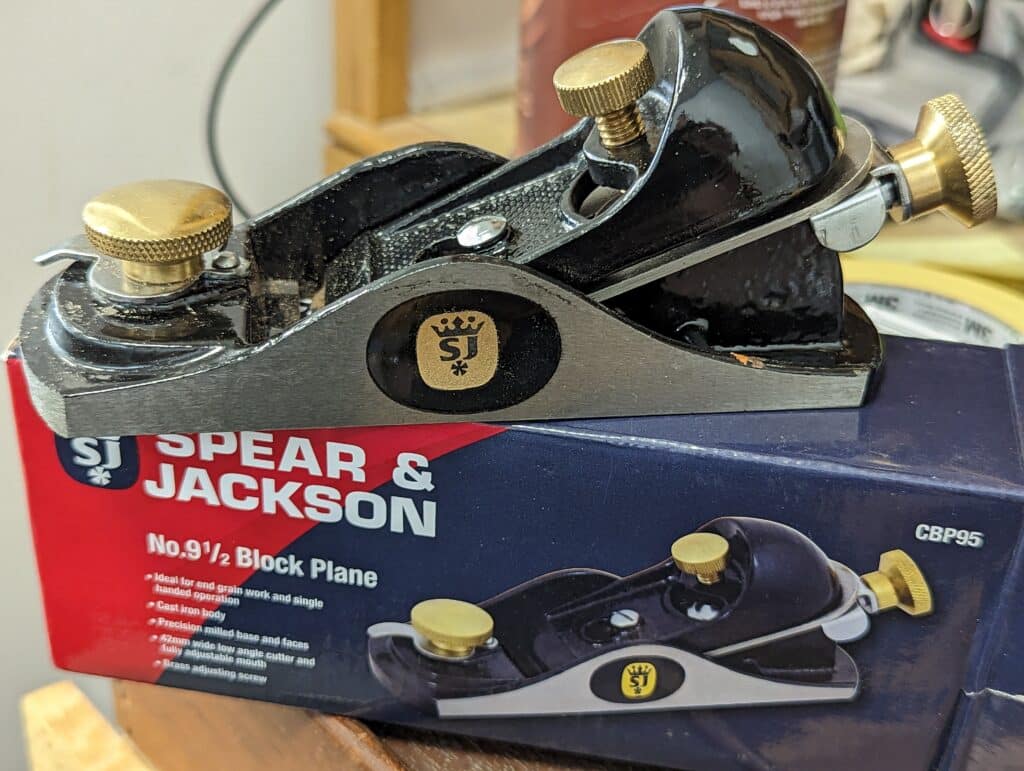
It is most unfortunate buying either of the Spear and Jackson block planes because most of sellers used the same image of one or the other planes interchangeably so you might think that the 6 1/2 is a high angle version or visa versa when they simply didn’t bother to trade out the image for the right one. Of course, the marketer in charge of selling online would not know a block plane from a house brick, I get that.
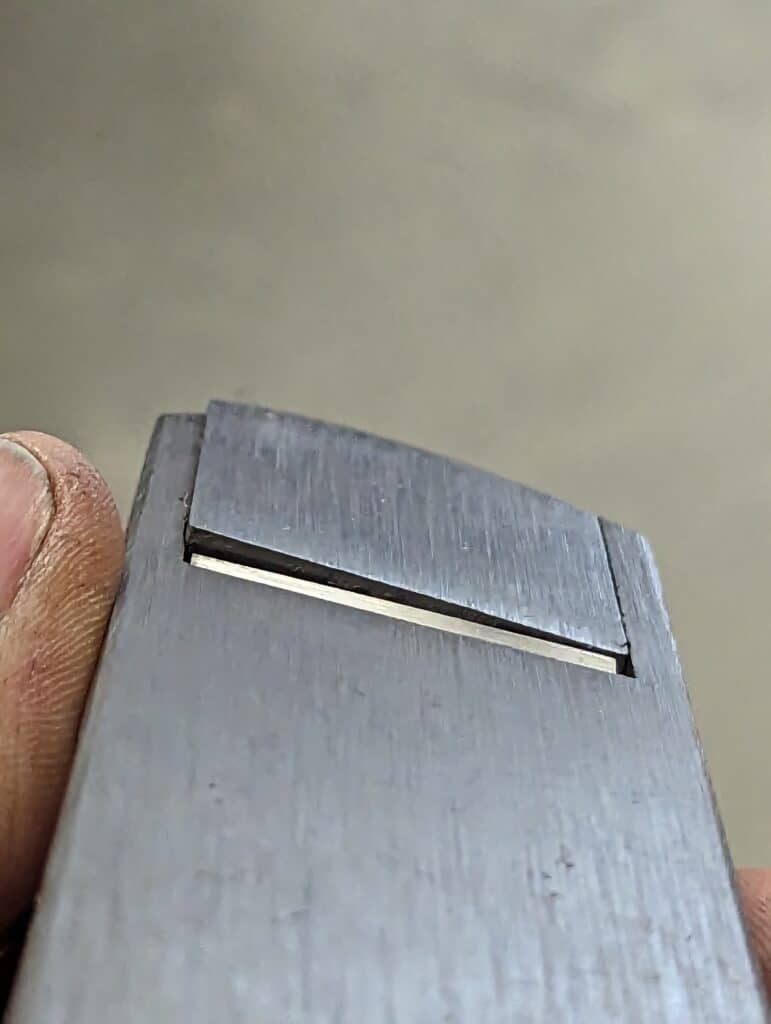
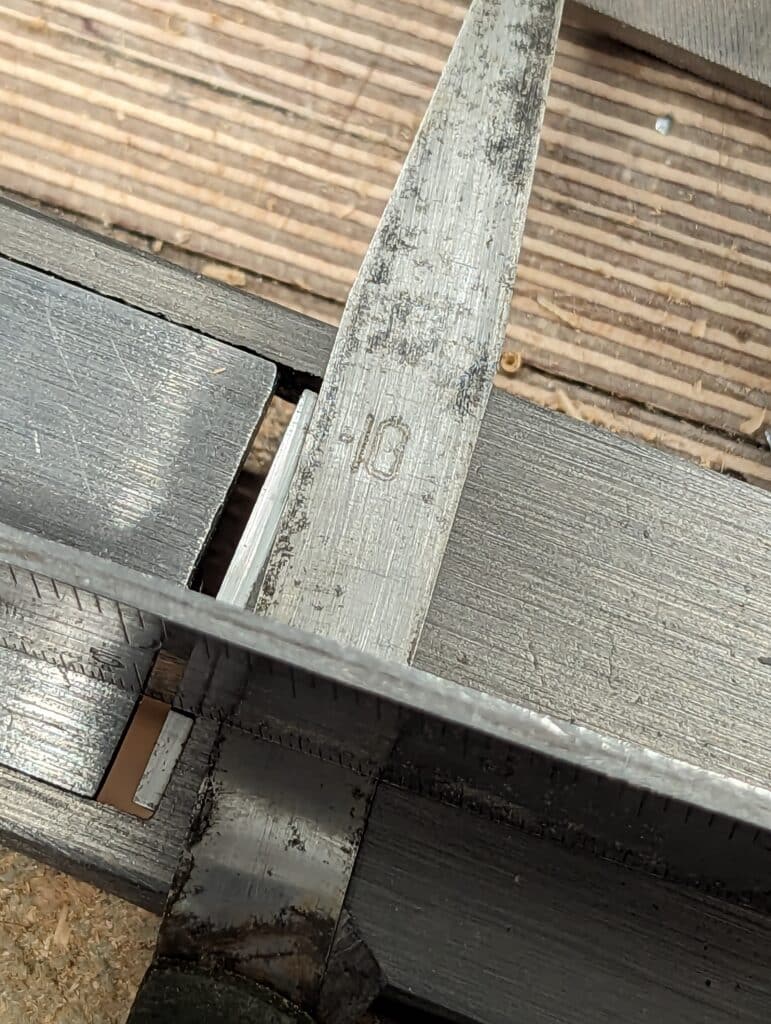
What really deterred me first was the increased weight and heft of it together with the additional sizing and the increase in metal added to it. Somehow manufacturers have drifted from user knowledge to manufacturers thinking they know what users need and want but without asking them. Imagine, if you will, making a plane that simply cannot and will not work and sending them out year on year by the thousands. The unsuspecting public who wanted something to ease a door will think it is them and not the tool and yet all of the ingredients are there in the plane for it to be a decent tool. Had they checked and set the planes prior to shipping they would have had a satisfied customer and that is what you get from the more premium makers. It’s not always that the better engineering gives you ten times the functionality but they are rigged up to take that shaving straight off out of the box. Of course, that is just temporary. Once the plane dulls the task of sharpening and resetting looms.
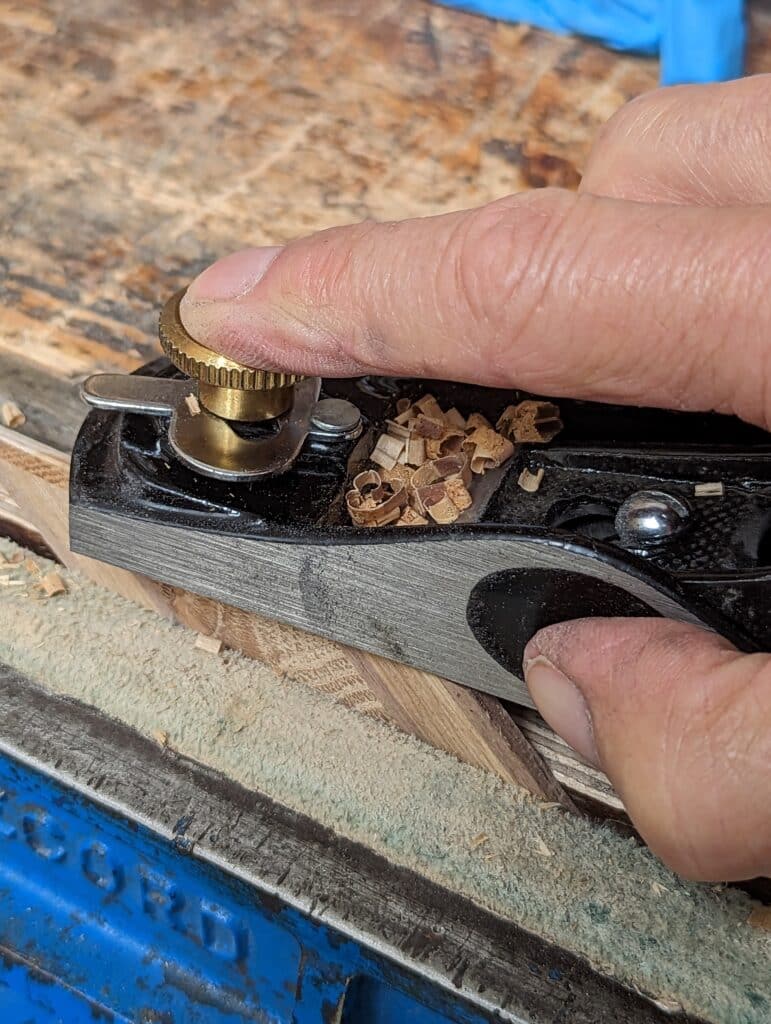
Where Stanley should be ashamed, they boast. Proudly embl;azened with the name is the date of their century-old and more history as plane makers. It’s actually doubtful in my mind that stanley actually make these planes and I have good reason to believe that. I cut S&J a little more slack as the ‘new‘ new kids on the block. Both Stanley and S&J have put weight on these block planes and with no good reason. They have done it for years now and I suspect that’s because they farm out production to some central Asian factory. You cannopt believe what it says on the packaging any more.
One main problem is associated with the lever cap locking the blade to the body of the plane. Instead of the lever cap applying ready pressure by the flip of the lever cam or a turn of the thumbscrew, people buying the plane must now cinch down the lever cap with that central set screw using a screwdriver even though that is NOT what this screw actually is intended for and quite incorrect. Whereas the setscrew might obviate the use of a screwdriver and gives the impression that this is the correct thing to do (and it is what you would assume) it’s exactly what not to do. The set screw simply helps to adjust the distance so that thereafter you can just flip the lever or loosen the brass knob that loosens the lever cap. This then enable you to take out the cutting iron for sharpening and then return it and simply flip the switch back or lock down the cutting iron with the knurled knob depending on the plane maker’s plane type mechanism. Both are fast and effective.
What the companies now offer really defies the Stanley legacy in what was probably the best design in block planes ever. 140 years have passed and we had a hundred years when block planes came as a working plane. I wonder who it is sitting in an anonymous office somewhere in the world that is so detached from the that they can put out such shoddy facsimiles. And doesn’t it amaze you that with all of our smarts, no modern maker gave us anything better that improved on what Stanley gave to us in the planes their designers created over a century ago? I mean, is all they can do is increase the material sizes? Then too, adjustment and forefinger knobs were made from three times as much brass, three times thicker, three times bulkier and three times heavier and that has to be better, right? Wrong!
And so then comes the cast-metal body. Why oh why do some makers, no, all of them, seem so wont to destroy good plane designs with a mass more weight? Weight is never an improvement to any hand tool. And I am not just talking about economy models either. For some reason, makers see weight and heft and mass as a positive thing. What they created to give us is an oversized draft horse bred purely for ploughing and hauling expecting it to perform as an Arabian–not only doesn’t it work it can’t! The funny thing is that 95% of these planes, no matter the maker, are simply Stanley knock-offs. As far as I am aware only Veritas of Canada has come up with a production line block plane that is totally their design. Why then if the bulk is indeed a mere knockoff of a Stanley can’t they realise that size and weight was intrinsic to Stanley’s design and these recent increases in bulk are a non-improving and unnecessary addition that costs more in materials yet makes no improvement to the product or its functionality? Indeed, its detrimental to it. Surely, that being so, it’s a no-brainer to just give us an identical plane? Why did they feel to ‘improve‘ what was tried and tested by the Western masters of production models for almost a century?
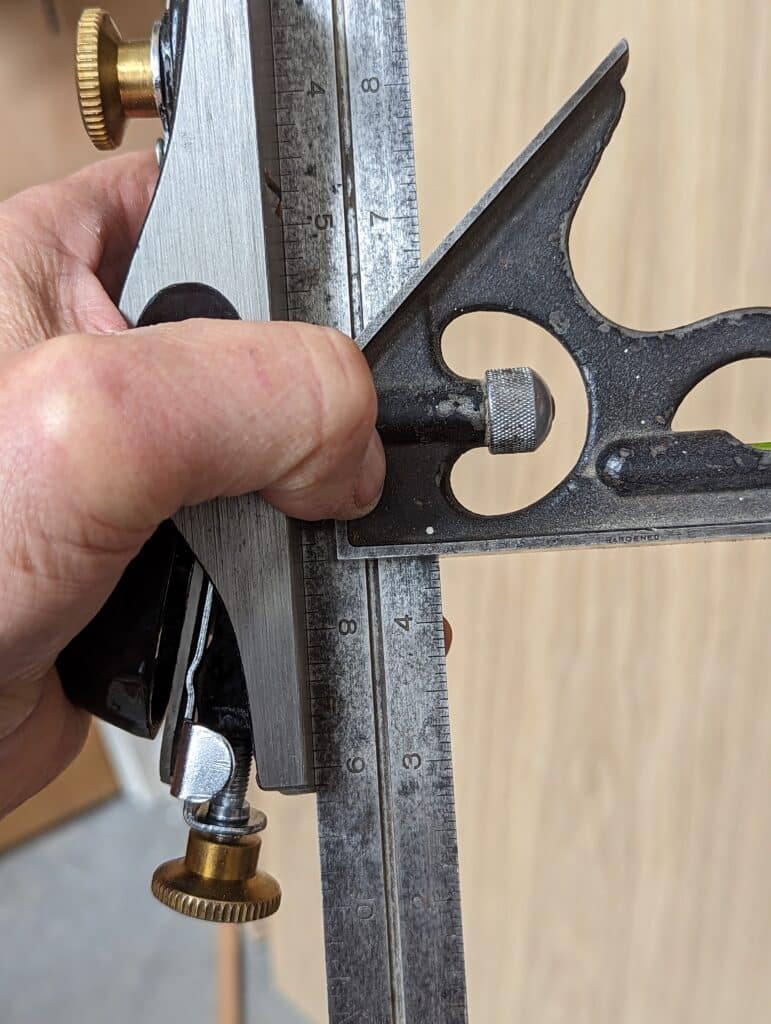
With these new planes ordered and arriving around the same time, I was struck by this one issue that occurred in all of the planes. Side by side, these planes had the upstand I spoke of. It begged the question are these planes made by the same maker in the same country and on the same continent in a single-output factory? As it is with many ‘Old and trusted names‘ of industry, you must now read between the lines, see what’s there but not written. Search for block plane on eBay and you will see the same image used by six different suppliers but with their own names on the planes. Many of these old and often well-known names do not make tools but are suppliers and distributors. The price range goes from around £13 on up to £50 but side by side in the hand they appear to be the same identical plane. Stickers somewhere are the only difference.
Surprisingly, the only one that actually worked out of the box was the cheapest of all at £13.99 with free shipping and a two-day delivery. Everything worked and screw thread tolerances were quite acceptable. I sharpened the cutting edge, loaded it and ran it along long-grain and end-grain oak.I have no way of testing for hardness and edge retention yet but I have no reason to believe it’s not good. A week working with it will tell me all I need to know.


It doesn’t surprise me that a cheaper product can be the best. A premium price simply for a name is not new. I remember from 4 decades ago that I could buy (and sell) exactly the same product from a supplier for 10% of their normal wholesale price. A different supplier rep complained that their company had sold one of their products to a different supplier so that its selling price was lower than he could sell it to us wholesale.
I am often amused when I see people comment that you only get what you pay for, implying more expensive is better, you are often paying a lot more for them to advertise their brand.
For clarity, is the plane you are using 6 1/2 inch block plain or 9 1/2 inch?
If you weigh an old equivalent block plane, how much the traditional plain weigh? It appears that the new Spear & Jackson model weights slightly under 2 pounds.
It’d be interesting to see the additional marketing costs for these companies. Have they simply just replaced quality checking with advertising? More worryingly, have companies everywhere discovered that marketing is more beneficial to the bottom line than quality? It’s become very clear to me that our global economy no longer provides a useful measure of value (perhaps it never did). It’s become more and more abstract from reality. Whether its the financialisation of everything, where money is hedged against money, or the value of advertising and data over the physical, it’s like the system has taken over – everything is now done to perpetuate the system (growth, I suppose) rather than for beauty, happiness or love. Maybe it’s the way it’s always been.
Well in my lifetime wholly it’s the financial bottom line for just about every producer I know of. The most unfortunate thing is that people generally measure any and all success by the mount of money made. Which sportsperson is not measured by how much they got for the game played? Or which company head or founder is not presented with the preface “Billionaire . . .” or “Millionaire politician blah, blah, blah? The most searched for term for Paul Sellers woodworker is, ‘How much is Paul Sellers worth?” and the sum given is thousands of times my actual income. I guess now it will go even higher just because people will automatically copy and paste the question.
He is priceless!
Perfect answer…Agree!
I’ve been reflecting on this very question. I’m a painter and decorator by day. I’m content with how much I am compensated for my work until other people tell me I should charge more and charge for every “extra”. To me, the key thing is my pride in a quality job. If it takes half and hour of extra sanding to get a more perfect finish, I am happy to do so. I leave the job more content with my work.
Christopher,
I think that if we’re going to define our lives by our work (which is the way of the modern world), then yours is most certainly the right attitude. By not compromising on your work, you’re saving yourself the mental gymnastics required to justify being unfair to your customer (aka: another human). In my opinion, that must make your life easier in many ways. I’ve seen guys that do the opposite, and the ego and ugliness required to be constantly on the defence of such a position (the sort of thing we tell our children not to do when they’re growing up) must be intolerable. It breaks the character of a person. Turns nice people into nasty individuals. I’m glad that there are people like you refusing to enable the ultra competitive money-driven approach. Best of luck to you.
Hi Paul. What do you think of the Record/Marples 601/2 block planes – made in the 1980ies I guess? Are they a workable alternative to some of the other options?
While I think of it, I’m not sure I’ve heard your view on the old Marples M planes? You usually refer to Stanley and Record planes. And you’ve also commented favourably on the quality of Woden planes. But I can’t recall what you think of the old Marples planes. I’ve found one, from the early 1950ies, and it feels particularly well made compared to its contemporaries. Do you rate them at all?
The Marples planes were not very popular and WERE nowhere near at as high a production level as Stanley and Record so were very rarely seen. The Swedish woodworking tool makers Bahco bought the then Record-Ridgway Tools in 1981 and renamed the company as Record Holdings. Ovber the ensuing years they renamed and rebranded it to Record Marples (Woodworking Tools) Ltd eventually assuming the hybrid name of Record Marples. It felt at this time that a downward spiral had begun in Sheffield and companies were bought out using the names only and not really the quality of manufacturing. The bench and block planes were not really known for quality after that as I assume some guy in an office took the nakers in a wrong direction. What they should have done was double the price and deliver an improved quality. Remember they were already set up with over a centuries worth of capability buildings, manufacturing equipment and so much more. You would think they could at least match the engineers in garden sheds and home garages that came in with a quality that far exceeded anything ever produced by Record but their arrogance blinded them. Even now they live on their father’s reputation. I think plane in hand is telling you something and you should enjoy it of indeed you found a good one.
It was obviously a period of great upheaval for the firm as the company was renamed a further three times in the 1990’s — Record Tools Ltd. in 1991, Record Holdings plc in 1993 and then Record Tools Ltd. (a division of American Tool Companies Inc) in 1998.
Thanks Paul. Yes, the Record Marples block plane feels a bit like a ‘second’ and isnt finished too well. The Marples #4 though does feel tight and well finished – as you say, I may just be lucky with this one, or perhaps someone who knew what they were doing did a thorough fettling job on it some time before? I prefer the old tools to the new, even the premium brands – they feel properly worn in by the hands of craftsmen. And all the better for it.
There can be no doubt that a well-worn and well-used Stanley or Record records the work of those who went before us. There can be no doubt that these vintage versions will always be better than anything any premium maker can give us simply because they operate so smoothly.
Good morning Paul,
I was wondering if you could speak on the usage of block planes? From previous comments you’ve made I’ve come to the conclusion that they are not at all required, and perhaps to be avoided in a minimalist tool shop. I certainly don’t “need” one, but as I’m starting to make a bit more in my modest shop I am curious as to where and when one might find a block plane useful, and if purchasing one what qualities should I be looking for? — You mentioned bedding angle, but are their other things I should be looking for?
Thank you!
I think mostly I was trying to counter idiotic writings by some advocating that they used others for the tasks of the smoothing planes and jacks. These planes cannot and will not do that. I saw the most stupid article about pare cutting dovetails for that perfect fit recently and it made me realise why I stopped reading magazines purportedly talking about working wood. The same happened with one on block planes. Arghh!
Block planes are very limited in general woodworking. If someone is constantly working on thin wood trimming slender pieces, mitres and such, then the block plane is often sized for this work type and you might be excused for saying, “I use this plane all the time.“. Mine is indeed fairly close to hand. Sometimes my smoother may remove an arris and leave a slight snag point. For every two feet, there might be a quarter inch of a snag and the block plane will touch up the surface well. I noticed in my recent research that the sellers, 99.9% of whom never touched wood with hand tools, now call this the “one-handed plane. Of course, it can be used single-handedly to take off a hard corner but the steadying of a second hand at the front cannot be beaten. I don’t really accept but I do pursue the practical. Terms like minimalist have become catchphrases to somehow latch on to. I own many woodworking tools and would consider myself the pragmatic woodworker in my choices of more planes than others would consider minimalist. I often have a mix of two number 4s, two jacks and two converted and adapted scrub planes on the bench at once. It is highly practical and saves much time in sharpening. Intermingled there there will be a block plane or even two and a bullnose. My personal view is that the 12º bed gives you the advantage of a low angle for the end grain which gives the cutting edge a more direct and inline thrust behind the plane. This works well on super-narrow stock either with or across the grain. I would suggest finding an old model 60 1/2 Stanley. If you are in the USA they are quite plentiful and fairly priced. I do not think paying up to £60 is too much to pay really.
Old planes are getting harder to find here anymore. It’s not like it used to be. Where you could find planes here and there for cheap. Lots end up online now.
One handed plane! That is a funny way to advertise. What is your other hand doing that is so pressing that it can’t be called into steadying your chamfer?
My block planes are from a flee market. Two do not work well at all, but the third one is functional (it has the side to side adjustment, which helps). I do use it for smoothing, unfortunately, as I don’t own a smoothing plane.
New subject: what size file for saw with 4.5 to 5 ppi or teeth not sure where to measure gullet or points?
Congrats for such a seamless thread hijack. I use a three faced file where each face is twice the width of the edge being sharpened, such that the file can be rotated to use fresh surfaces when dulled. Bahco make a reliable range.
PPI stands for, “Points Per Inch” so that’s a clue. If it’s 4.5 it’d be 4 points and an inch would end at the bottom of a gullet. 4.5 and 5 likely use the same file anyways. Generally a file size sharpens a range of different PPIs. There’s even some debate as to what’s best. It’s mainly down to personal preference. What you’re comfortable with using. It’s more of a factor at higher pitches. Then you get into needle files there. There’s also an economy factor as well. Some favor larger files for more sharpenings.
I think Prof Sellers has a free video on this, somewheres. I need to look it up too, as I’ve not sharpened the saws in a while. Keep in mind, cross cut and rip cut saws use different angles.
I have a Stanley 60-1/2. It cost me 75 cents. It even had the paper label on it still when I got it. But that did just fall off in short order. Heck I didn’t even know those old planes had paper labels on them. I’d never seen one before. It was a little oval sticker that said Stanley on it. That was a lucky garage sale find. But I don’t actually use it. I have a lot of block planes. I found a late model 12-220 that I like and use. I paid a dollar for it. Other than missing the front knob when I got it that plane is dang near new condition. I made a knob out of wood for it and managed to get it to screw on. I think that wooden knob I made is a large part of why I like that plane. It came with a horrible little plastic knob. That wooden knob is so tactile for me. I love how it feels. I can only imagine how little I’d like a plastic one.
I have had a couple of old Marples no5 planes and found that the irons were very soft. I was possibly unlucky to get them after someone overheated the steel on a grinder.
The fit of the components seemed a bit sloppy and I sold them on.
The increase in weight of modern planes may be due to inferior castings being used. Manufacturers may simply be making them thicker to provide the necessary strength.
They all seem a bit dead compared to older ones.
Modern spokeshaves are often useless as the adjustment nuts prevent the iron from sitting on the bed of the tool.
Poor machining and components which are the wrong size to be compatible.
Don’t get me started on chisels with steel you could bite through.
I do think that there is a market for no frills, well made tools at a sensible price.
As that famous boat-builder, Uffa Fox, once said: “Weight is only useful when building steam rollers”.
It never occurred to me to wonder” what is Paul Sellers worth?”; for me your
value is immeasurable. Thanks for all that you do.
After getting pretty good with planes, especially my Stanley’s #4 and #5 1/4, I took a break from woodworking due to health reasons. Yesterday, I picked up my #4, sharpened it and proceeded to tear up a previously nice walnut board. Fortunately the wood is thick enough to repair. It looks like I have to reacquaint myself with certain tools.
Weight up to about 4 kg is an advantage when we’re talking about a hammer and about ramming fence posts into the ground. Perhaps they should screw long ash handles to their heavy duty planes?
Paul why no mention of the veritas low angle block plane or the lie Nielsen low angle block plane? I believe both are modeled after the 60 1/2.
prohibitive cost to many? on ebay used 60 1/2 start at 10 bucks while veritas starts over 150ish. so there is a barrier to entry there. I love Lee Valley tools but not everyone is at a place where they can afford them.
i totally get the cost issue and I applaud paul for his approach, however, to give the impression that these options don’t exist is a bit silly in my opinion.
150 bucks for a block plane is a lot (even if it is perfect, which no doubt it is). Hardware stores sell nonfunctional versions for $29.99 after all (like the one my Dad used, mostly for paint removal).
But seriously though, some hobbyists have jobs and other stuff to allocate time or money towards, respectively, and despite not being ‘poor’, might still need to think about cost benefit ratios. (course I am on overly frugal side, most would say).
I suspect that you know the reason but here goes. I decide to do my best never to send my audience to expensive products when tools just as effective will do the job for a fraction of the price but I will mention them from time to time as and when needed though not as a comparable tool. Dare I wonder why you singled out North American makers alone and didn’t mention two dozen other makers from Asia and other parts of the world. As your question seems to me a bit loaded, I thought I might offer the same. Though these two makers are fine tool makers, there is a huge difference for people starting out or on low incomes between a £20 plane and a £250 for a Lie Nielsen. That’s a lot of money if someone wants to start out woodworking and has yet to see if she or he will stick with it. Veritas planes I enjoy too as a privileged user and have expounded on these in the past too. But still, £200 for a truly non-essential plane is still very high for the same reason and of course, prohibitive to the majority of woodworkers focussing on hand tools. Oh, and the Veritas is not a knockoff of any other make as they design their own unique range of planes.
Thank you Paul for keeping us updated on the doings of the woodworking tools industry. You make an excellent point about new users believing their skills are lacking when in fact it is the tools that are failing them. BTW to answer a reader question, the S&J 9 1/2 plane, CBP 95 on the box, is indeed a 6 1/2 plane. Why they use such a misleading numbering is another clue to their… lack of clues!
wow !! thank you for this post Paul!! i had bought a Stanley and tuned it all up and sharpend the blade etc … but it kept falling apart on me when i tried to use it ..so .. i never used it and thought it was a waste of money and time After reading your post i checked my plane and sure enough i had the same issue ..a few file strokes and suddenly io have a functioning plane ! thank you ! you helped me to turned a plane i hated and never used into something that works really well !!!
Regarding newer features that are not helpful: Years ago, I used to belong to a few “focus groups”. It’s really just a paid grouping of people from different demographics. The manufacturers, or more likely the marketers would introduce a product to us and ask questions about what we liked or disliked about the product. In most of the groups, the people were not chosen for their expertise. The organizers wanted opinions from consumers, and the thought was that if the consumers in the group were pleased with certain features, then they would make sure that those features were present in hopes that this would lead to increased sales. So when most of those people picked up a tool, they may have liked the fact that it was heavier, because to untrained users, bigger and heavier means higher quality, even if the opposite is the truth to a knowledgeable user.
I have a Stanley SB3 that I bought in about 1978 I think. It’s the only plane I ever bought new. Can’t remember how much I paid but it won’t have been much – I was pretty hard up in those days.
I think you have mentioned Paul that it’s not a tool you like but here’s the thing. It has Stanley name cast in the frame. It also has ” Made in England” but I know it was made in India. I had the pleasure of getting to know a man in India whose family owned the factory!
Yes, it’s a fiddly thing to set up and adjust with two depth screws and no lever cap but it’s straight and flat with a decent iron (now nearly worn away) and it’s not heavy. I’ve always liked it.
Like you I’ll probably have more than one plane to hand, usually one set a bit aggressively and another set fine and the old junky SB3 will usually be one of them.
I guess old tools become old friends in the end.
I’m a diesel engineer in real life but I haven’t bought any modern tools for around forty years, or very few anyway. I have tools made by my great grandfather as a shipyard apprentice that I use almost daily and wouldn’t part with for anything, and my treasured best set of Whitworth spanners are Royal Navy surplus – the box was dated 1931.
I really enjoyed this post Paul and I have learned something too. I know now to inspect new gear for interference from bad finishing. At least, if I ever buy new gear! Thank you.
I doubt very much that I actually said anywhere that I didn’t like it as I do like them but that they are highly limited in functionality and are not a smoothing plane as in a bench plane in the bench plane category of planes.
I am still using the Millers Falls #57 low angle block plane my father gave in the the late ’60s. It has all the best features of the old Stanley block planes.
Have you ever seen/used any Millers Falls planes?
Hi all, thank you Paul for another thoughtful and thought-provoking post!
This is gonna be a comment on topic, though one could say ‘across the grain’:
I can speak based on my own aches and pains that the issue of “improving things for worse”, when they weren’t needing change at all in the first place is a human condition. And it manifest itself exactly as you described for tools …in a modern corporate environment too. 😐
Time and time again I see this or that big shot walking in guns a-blazing, throwing a huge ‘restructure’ (elephants and dancing horses included) which mostly delivers two things: self prompt, and efficiency drops. (the former intentional, the latter collateral damage)
It is the idea that changing ‘proves’ you engineer/general manager knows best than anyone before you.
…and unfortunately many decision-makers buy the idea.
So here we are. To the detriment of customers and production/delivery workers alike.
—-deep breath—-
I personally think the reason behind the weight=quality logic in product design is really a formula some think-tank came up with based on customer research …and I think said customers where reacting to the seven of plastic, and how the really flimsy plastic copies of formerly reliable products made of other heavier materials ‘feel’.
So “add weight > customer thinks it is good quality (at purchase time, before even unboxing) > more sales.”
Finally, I appreciate your dry humor (and puns!) almost as much as I do your knowledgeable teachings 👌
(Even when it is a tad mean 😜):
“…would not know a block plane from a house brick” 😂
Thank you Paul,
Ngā mihi nui
*self promotion (pardon my auto incorrector)
*and ‘advent’ of plastic
Request: ability to edit one’s own post for 2 minutes after posting?!
Limits troubling edits post-replies, but pleases niggly spellers like yours truly 😬
*the ‘advent’ of plastic
The heavier planes phenomenon is odd. We have transitional planes because woodworkers found the iron equivalents to their wooden planes too heavy. Now we’ve swung to “now, even heavier!” as a selling point, but none except the highest end flatten their soles, blades, and chip breakers.
My best guess is that it’s a reaction to modern tool quality in general. “We” want things a little hefty and sturdy like our dad’s or grandpa’s tools. It’s cheap to add mass (we don’t have a world war) but expensive to add steps like additional or better machining. Even these thick replacement irons drive me nuts. It’s not a useful contribution to the edge and it’s more metal to sharpen.
I wish one of the traditional brands would bring in someone like you to advise. They could likely optimize cost of a product for the modern economy but achieve the proper functional end result.
I gave up on new. I can’t afford Veritas, etc. as a hobbyist. It takes hours setting up a lesser new plane and the end result always feels lacking. Even with the price of used doubling in the past few years, it’s easier to clean one up and do less fettling. The end result is inevitably more comfortable and reliable.
I’m not an “older is better” or “newer is better” person. Just want the best experience per unit money.
Net worth… Well, they paid 30 pieces of silver for Jesus, so I would not dare to put you up for more than 29. 😉
It’s been a great thread this article has prompted. Given the wider reflections on planes I’ve a related question Paul – on the merits of bronze bodied planes? I’ve never handled a Lie Nielsen bronze and I’m never likely to own one given their price, but I wondered whether the bronze gives them an special properties when it comes to planing use, or is it simply resistance to rust? If it’s just rust protection and looks then that feels a very expensive rationale for making them – but perhaps they also perform better than steel in some way?
Sorry, I hate to be negative but the weight alone on any of the so-called premium planes no matter the maker has just put me off because it is not at all any kind of benefit.
Thank you Paul for the first part of this post! I use the cheapest version of Stanley’s block plane’s that i could find on russian market… And the problem you showed on first photo, was really annoying to me… but now, when i’m done whith all of your suggestions, everything is OK… plane works really better!
The lever cam on the Stanley 60 1/2 that I bought 10 to 15 years ago drives me insane. I often bump it during use and then need to setup the plane all over again. If I recall correctly, very little fettling was required on this plane (10-15 yr ago, mind you), but maybe I was lucky.
I bought a Lie Nielson rabbet block plane about 5 years ago and it has a different design problem, in my opinion. The lever cap is tensioned with a knurled knob, but that knob drives a pointed rod into the blade to develop tension. The problem is that this design makes it very difficult to use the depth adjustment mechanism once the lever cap is tensioned. By comparison, the Stanley design applies pressure through an extended disk or washer. I modified by LN by putting a washer under the pin and it helped, although this just produced a different inconvenience. My impression is that many have noted this flaw, but I am not aware of LN making a correction.
I will plumb for a vintage version of Stanley every time, Ed, not that I need to buy any more. Ireally like these and they have no issues.
For the 10 y.o. Stanley 60 1/2, I suspect it could be improved if I could just figure out what the issue is. I’ll look again. For some reason, the cam is acting more like a simple friction lock instead of a cam. In any case, with even a little care during use, the plane is quite usable and cuts nicely although, if I recall correctly, the factory grinding on the back of the blade was coarse and took work to flatten. I could buy a vintage Stanley for comparison, but really don’t need one.
Despite the frustrations, I’m glad to have the LN rabbet block plane and use it a fair bit. It is definitely a luxury. One use is removing material off of tenons quickly, working to the gauge lines, before a final perfecting cut with the router plane or, going the other way, taking a shaving after the router plane when the mortise isn’t exactly parallel-sided. Of course, that could be done with a #4 and maybe a lick with the chisel by the shoulder, but the luxury of the rabbet plane configuration is enjoyable.
You know what tool I would likely never buy? A #10 “rabbet bench plane.” I see them in antique shops and flea markets and have _never_ seen one that was usable. Invariably, the toe is in twist relative to the rest of the sole and I’ve seen them with cracks on the cheeks. Also, I don’t see the need for them unless, maybe, making big tenoned doors 100% of the time. The block plane version (like the LN) I find a useful luxury, but the #10, I don’t understand.
To work a raised panel for example.
What’s interesting is that I bought an inexpensive 60 1/2 clone about 15 years ago. It came equipped with the same ridge on the lateral adjuster. I didn’t file mine down. Being inherently lazy I used a bench grinder.
Still, it’s inexplicable that the part could be made so exactly wrong for years. Just punching a hole would seem to be cheaper to do. Someone somewhere had to think it must be made that way!
-Tom Stenzel
I am sitting here looking at my 60 1/2 block plane, I am not exactly sure when I bought it but it was at least 40, probably 45, years ago. I was quite young and excited to have it until I opened the box. Even though it was made in England (I am in Australia), the quality was abysmal. Most of it appeared to have been finished on a linisher (belt sander) with little care or skill, the sole was way out of, well everything, it wasn’t flat, it wasn’t true, the adjustable mouth was terrible (okay, the silver soldered joint looked good), and worst of all, the mouth was crooked and misaligned as the sole had been ground at an angle. The sides were way out of square, weren’t flat, and weren’t parallel. The iron was equally poorly finished, it was hard perhaps too hard but came to a good sharp edge, even the name sticker was on crooked. Fortunately, in my early days of an apprenticeship (not wood working related) I had been taught to shape metal with hand files and was quite good at draw filing (at that time Australian made Wiltshire files were still available, these days I spend time buying up old rusty files, about 30% are in very good condition once they are cleaned up and carded to within an inch of their lives – sadly, sometimes, sellers sometimes try to help by “sharpening” them using vinegar and other corrosives, how people think that indiscriminate bulk removal of metal is going to sharpen anything is beyond me). Even so, it took a long time to get that plane into a good working condition.
About 4 years ago, after retiring and stopping travel, I decided to finally get it right. Much work with a metal scraper (a scraper made to remove metal not a wood scraper made of metal) followed by precision diamond stones, etc. have finally made it “feel” right. It is now a joy to use.
The best Stanley plane I have is a fluted base, wide blade, No 7 I inherited from my step grandfather, through my father. He was a boat builder, and the No 7 was one of the few metal planes he owned, (I also have a bronze No 4 he had, he must have broken the main casting and had a local engineering blacksmith cast up a bronze replacement using the broken casting as a pattern, it is a bit crude in places but a real conversation piece, it also works well despite the wear in the sole). After he died, the No 7 was abandoned on a pile of rubbish for several years, with the result being just a little pitting on the heel of the sole. I cleaned it up with 000 steel wool (carefully using my best files and stones to correct the problem in the sole) and rubbed it down with my usual mix of paraffin wax softened with paraffin oil, followed by a polish with a clean rag. It was in fantastic condition, it had never been touched until I cleaned up the sole. There are no signs of “tuning”, everything was/is flat, true and square. Judging by the iron, it was well-used. At the time (40 years or more ago) I managed to get a new carbon steel iron made in Australia by Stanley, and an Australian made Stanley iron that was carbon steel at the back with about an inch of HSS steel silver soldered to the front as the cutting edge. I use the HSS blade on the high silicate content hardwoods that grow in Australia, and on manufactured wood paneling. It has always been a joy to use, it is in beautiful unrestored and original condition, and, made in Canada!